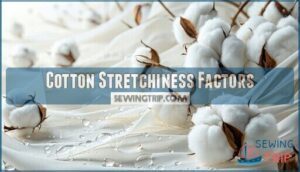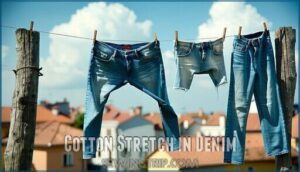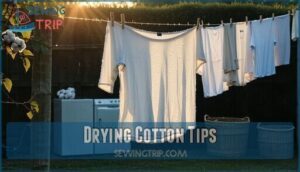This site is supported by our readers. We may earn a commission, at no cost to you, if you purchase through links.

However, moisture acts like a temporary stretch enhancer, letting cotton give way under pressure before snapping back.
The real game-changer? Fabric blends, specifically when cotton teams up with elastane or spandex, you’ll get fabrics that stretch 15-25% while maintaining cotton’s breathability and comfort.
Your cotton t-shirt might feel snug after washing because heat causes shrinkage, which actually reduces any existing stretch.
Think of cotton like a stubborn friend—it’ll bend a little under pressure but prefers staying put rather than stretching out of shape.
Table Of Contents
Key Takeaways
- Pure cotton doesn’t stretch much on its own—you’ll only get 2-5% natural elasticity, but moisture temporarily enhances this stretch before the fabric snaps back to shape.
- Cotton-elastane blends are your best bet for stretch, adding just 2-5% spandex or elastane gives you 15-25% stretch while keeping cotton’s breathability and comfort.
- Heat causes cotton to shrink rather than stretch, so you’ll notice your cotton shirts feel tighter after hot washing because the fibers contract and reduce any existing stretch.
- You can temporarily stretch tight cotton clothes by dampening them with water and gently pulling the fabric while wet, as moisture makes cotton fibers more pliable for reshaping.
Cotton Fabric Basics
Understanding cotton’s basic properties helps you make informed fabric choices for your clothing needs.
Cotton’s natural fiber structure, weave pattern, and thread density determine how much the fabric will stretch and perform over time, which is crucial for making the right choices.
Cotton Types
When exploring cotton’s stretch potential, you’ll encounter diverse cotton types with unique properties.
Organic Cotton maintains purity without chemical treatments, while Cotton Blends incorporate elastane for enhanced stretch.
Egyptian Cotton and Pima Cotton offer superior fiber length and strength.
Mercerized Cotton undergoes chemical processing for increased luster and durability.
Each type affects cotton fabric stretch differently, influencing cotton stretch properties and determining whether cotton material stretch meets your needs, considering the overall stretch potential.
Cotton Weave
Three primary weave patterns determine cotton fabric elasticity and stretch potential.
Plain weave creates the tightest textile structure with minimal stretch, while twill and satin weaves offer slightly more flexibility due to their diagonal yarn arrangement.
Cotton threads interlace differently in each pattern, affecting fabric density and overall stretch cotton fabric performance in your garments, which is influenced by the diagonal yarn arrangement.
Cotton Thread Count
Thread count measures how many yarns you’ll find per square inch of cotton fabric, directly impacting fabric softness and cotton density.
Higher thread counts don’t automatically guarantee better cotton stretch or elasticity of cotton.
- Thread Quality affects durability more than cotton stretchability
- Yarn Thickness influences comfort and breathability levels
- Weave Patterns determine final fabric texture and feel
- Cotton fabric elasticity stays limited regardless of count
Understanding cotton fabric properties is essential for working with different types of cotton fabrics.
Does Cotton Stretch
Pure cotton typically doesn’t stretch much on its own. Cotton Fiber naturally lacks elasticity compared to synthetic materials, making traditional cotton fabrics relatively rigid.
Cotton’s natural fibers resist stretching, keeping fabrics beautifully structured but wonderfully stubborn.
However, understanding Material Properties helps you make informed decisions about Clothing Fit and fabric selection. This knowledge is crucial for choosing the right fabric for your needs.
| Cotton Type | Stretch Factor | Common Uses |
|---|---|---|
| 100% Cotton | Minimal (2-3%) | T-shirts, jeans |
| Cotton Blend | Moderate (5-15%) | Activewear, fitted clothing |
| Stretch Cotton Fabric | High (15-30%) | Yoga pants, skinny jeans |
The Cotton Stretch Factor depends heavily on construction and additives. Pure cotton’s molecular structure creates strong bonds that resist stretching, while Textile Science shows that weave patterns affect flexibility. Fabric Dye processes can also influence elasticity by altering fiber structure.
Most "cotton stretchy" garments contain elastane or spandex blends. These synthetic fibers give cotton the stretch you’re looking for without compromising breathability. When shopping, check labels carefully—true stretch requires more than just cotton.
Cotton Stretchiness Factors
Several key factors determine how much your cotton fabric will stretch during use. Moisture exposure, fabric composition, and general wear patterns all influence the stretchability of cotton fibers over time.
Moisture Impact
Water acts like a temporary loosening agent for cotton fibers.
When you expose cotton to moisture, the fibers absorb water and swell, creating increased fabric stretchability.
This cotton stretch factor becomes most noticeable at higher humidity effects levels.
Your cotton fabric stretchability returns after proper drying methods, though cotton elasticity properties remain affected.
Understanding the cotton stretch factors is essential for maintaining fabric quality.
Fabric Blend
Fabric blends reveal cotton’s hidden potential.
Material mixing with polyester creates cotton-polyester combinations that enhance durability and wrinkle resistance.
Textile science shows how fiber blends transform cotton fabric stretchability through strategic yarn composition integration.
Different fabric types offer unique advantages:
- Cotton-elastane blends provide significant stretch with 2-5% spandex content
- Cotton-polyester mixtures improve shape retention and reduce sagging
- Cotton-modal combinations increase softness while maintaining structural integrity
- Cotton-bamboo blends enhance moisture-wicking properties for activewear applications
These stretchy cotton fabric innovations demonstrate how textile properties change when manufacturers combine natural cotton fibers with synthetic materials, creating enhanced fabric elasticity.
The use of wrinkle resistant finishes can further improve the performance of these blends.
Wear and Tear
Over time, you’ll notice cotton’s natural fibers break down from regular use and washing cycles.
Thread breakage becomes visible as fabric fading occurs, while fiber damage accumulates through repeated stretching motions.
This material degradation affects cotton fabric stretchy properties, reducing overall fabric elasticity.
Your stretchy cotton clothes gradually lose their textile properties, making garment distress more apparent with continued wear.
Understanding fabric stretch properties is essential for maintaining the quality of your garments.
Cotton Shrinkage Vs Stretch
While cotton naturally shrinks when exposed to heat and moisture, it has minimal stretch compared to elastic fibers.
You’ll notice that pre-shrunk cotton fabrics maintain their shape better after washing, whereas untreated cotton can shrink up to 5% in both length and width during the first wash cycle, which often involves minimal care.
Pre-Shrinking Cotton
Manufacturers often pre-shrink cotton through Cotton Treatment processes that involve controlled moisture and heat exposure.
This Fabric Relaxation technique allows Yarn Preparation to stabilize fibers before weaving.
Weave Setting and Fiber Conditioning minimize dimensional changes in finished garments.
| Treatment Method | Temperature Range | Shrinkage Reduction |
|---|---|---|
| Steam Pre-shrinking | 180-200°F | 85-95% |
| Mechanical Relaxation | Room temp | 70-80% |
| Chemical Treatment | 140-160°F | 90-98% |
Pre-shrinking doesn’t affect cotton elasticity properties or make cotton stretchy fabric more elastic, but it prevents unexpected size changes that might make you think your cotton fabric stretchy when it’s actually returning to its original dimensions.
Cotton Care Tips
Proper cotton maintenance extends your garments’ lifespan while preserving their natural properties.
Following specific cotton care tips prevents unnecessary stretching and maintains fabric integrity.
Here’s your thorough care guide:
| Care Aspect | Best Practice | Why It Matters | Common Mistake |
|---|---|---|---|
| Cotton Softening | Use fabric softener sparingly | Prevents fiber breakdown | Overuse weakens fibers |
| Cotton Ironing | Medium heat, slightly damp | Maintains cotton elasticity properties | High heat damages structure |
| Cotton Storage | Cool, dry, breathable space | Prevents mildew and stretching | Plastic bags trap moisture |
| Thread Repair | Address loose threads immediately | Stops further unraveling | Ignoring small issues |
Remember that cotton’s stretch factor depends heavily on proper maintenance.
Fabric dyeing can alter cotton’s natural properties, so you’ll need adjusted care routines for colored garments.
Understanding the cotton care basics is essential for maintaining the quality and longevity of your cotton fabrics.
Measuring Cotton Stretch
You can accurately measure cotton’s stretch by using a simple test that compares the fabric’s original width to its maximum extension under gentle tension.
Professional textile testing involves applying standardized force measurements, but you’ll get reliable results by stretching a fabric sample horizontally and calculating the percentage increase from its resting state to determine the fabric’s stretch.
Cotton Elastane Blend
Adding elastane transforms cotton’s natural behavior completely.
Elastane turns rigid cotton into flexible, body-hugging fabric that moves with you.
When you blend 95% cotton with 5% elastane, you activate four-way stretch** capabilities that pure cotton simply can’t deliver.
This cotton elastane combination offers up to 100% stretch capacity while maintaining excellent shape retention.
The elastane properties create stretchy cotton material that bounces back after every wear, making your cotton clothes stretch without losing their original fit.
Understanding the cotton blend benefits is essential for selecting the right fabric for your needs.
Stretch Cotton Fabrics
Stretch cotton fabrics represent engineered textile science that combines cotton fibers with elastic materials like spandex or elastane.
You’ll find these cotton blends offer controlled fabric stretch while maintaining cotton’s breathability and comfort.
Here are three key stretch cotton material types:
- Cotton-spandex blends – Typically contain 2-5% elastane for moderate stretch factor cotton performance
- Cotton-polyester-spandex combinations – Provide enhanced durability and stretch recovery properties
- Ring-spun cotton elastane fabrics – Offer superior softness with reliable stretchy cotton material characteristics
Understanding these properties of cotton helps you select appropriate stretch cotton material for specific applications.
Cotton Stretch in Denim
When you’re shopping for jeans, understanding how denim stretches can make the difference between a perfect fit and a wardrobe disaster.
Traditional 100% cotton denim doesn’t stretch much, but modern stretch denim blends with elastane or spandex fibers give you flexibility and comfort while maintaining that classic denim look.
Denim Fabric Types
When exploring denim’s diverse landscape, you’ll find Cotton Blends and pure cotton creating distinct fabric personalities.
Traditional 100% cotton denim uses tight Denim Weaves for durability, while stretch cotton material incorporates Stretch Fibers like elastane for flexibility.
Selvedge varieties showcase premium cotton properties through shuttle-loom construction, and various Textile Finishes and Fabric Dye treatments affect how much cotton stretches, with each type offering unique stretch factor cotton characteristics.
Stretch Denim Benefits
Stretch denim transforms your wearing experience by combining cotton durability with enhanced fabric flex.
You’ll discover improved denim comfort through better stretch fit that moves with your body’s natural motion.
The material behavior adapts to daily activities while maintaining wear resistance.
- Enhanced mobility – stretch cotton allows unrestricted movement during bending and sitting
- Superior comfort – fabric care tips become simpler as clothing stretch reduces stress points
- Longer lifespan – cotton fibers maintain structural integrity despite repeated stretching cycles
Preventing Cotton Shrinkage
Cotton shrinkage happens when heat and moisture cause cotton fibers to contract and tighten, but you can prevent this with proper washing and drying techniques.
Understanding how cotton fibers react to temperature changes helps you maintain your clothes’ original fit and prevents that frustrating "**did my shirt just become a crop top?
" moment, which can be avoided by applying the right techniques**.
Washing Cotton Tips
Proper cotton cleaning starts with cold water to minimize fiber stress and prevent shrinkage.
Pre-treating stains fifteen minutes before washing improves stain removal effectiveness substantially.
| Cotton Cleaning Factor | Best Practice |
|---|---|
| Water Temperature | Cold water prevents shrinkage |
| Wash Cycles | Gentle cycles protect fibers |
| Fabric Softener | Avoid – reduces absorbency |
| Detergent Choice | pH-balanced, mild formulas |
Understanding material behavior helps you control garment care outcomes.
Clothing stretch prevention requires gentle handling throughout fabric care tips application.
To maintain the quality of cotton fabrics, this is vital: follow cotton care methods that reduce shrinkage and damage.
Drying Cotton Tips
Anyone can master cotton drying with the right approach.
Set your dryer to low heat and remove garments while slightly damp to prevent fiber damage and excessive shrinkage.
Air drying remains the gentlest method for cotton care, preserving natural fiber characteristics and preventing the tight weave from contracting.
Does cotton stretch when properly dried? Yes, maintaining fabric softening through correct dryer settings helps retain garment flexibility and extends clothing maintenance cycles substantially, which is crucial for cotton care.
Stretching Cotton Clothes
If you’ve got cotton clothes that feel too snug, don’t panic—you can stretch them back to a comfortable fit using simple techniques.
Cotton fibers naturally respond to moisture and gentle manipulation, making it possible to regain lost dimensions through targeted stretching methods, which is a key factor in restoring the original fit of your cotton clothes.
Stretching Cotton Shirts
You can stretch cotton shirts by dampening the fabric and gently pulling while wet.
Cotton fiber responds to moisture, making textile manipulation easier. Focus on problem areas like sleeves or torso length.
The cotton yarn structure allows temporary expansion when clothing maintenance includes careful stretching. Natural fibers like cotton demonstrate specific fiber characteristics that enable controlled reshaping without compromising textile durability or fabric dye integrity.
Understanding cotton stretch shirts is essential for effective clothing care and maintenance, which involves careful stretching and awareness of textile manipulation to ensure controlled reshaping of the fabric, as seen in cotton stretch shirts.
Stretching Cotton Pants
Precision becomes your ally when transforming snug cotton pants into comfortable garments.
Cotton elasticity responds to moisture and gentle manipulation, allowing fabric stretch without compromising textile durability.
- Dampen fabric evenly – Spray water on tight areas to activate natural fibers for easier manipulation
- Apply gentle tension – Pull seams and waistbands while damp to encourage pant fitting improvements
- Use fabric conditioner – Softens cotton fibers, enhancing stretch recovery and cotton comfort during wear
- Air dry while stretched – Maintain desired shape as moisture evaporates, preserving your textile innovation efforts
Stretching Cotton Socks
Cotton socks resist stretching due to their natural fiber structure, but you can expand them slightly using moisture and gentle manipulation.
Dampen the sock material with warm water, then carefully pull the fabric around problem areas like the toe seam.
Cotton yarn responds better to gradual stretching than aggressive force.
Modern knit patterns and fabric technology create socks with improved elasticity, while fabric dye won’t affect stretchability.
This textile innovation in garment construction helps maintain sock shape while allowing minor adjustments for better fit, utilizing natural fiber properties.
Caring for Stretch Cotton
Once you’ve successfully stretched your cotton garment, proper maintenance becomes essential for preserving its newly adjusted fit and overall fabric integrity.
Stretch cotton requires specific care techniques to maintain elasticity while preventing fiber degradation and premature wear, and this is crucial for preserving the integrity of the fabric.
Cotton Fabric Maintenance
Proper fabric technology guarantees your stretch cotton maintains its elasticity and durability.
Regular Cotton Dyeing refreshes faded garments while preserving fiber integrity.
Use gentle Fabric Softening techniques to prevent stiffness without compromising textile engineering.
Master Cotton Ironing at medium heat to avoid damaging elastane fibers.
Address Thread Repair promptly to prevent further deterioration.
Quality Fabric Finishing protects against wear while maintaining the garment construction that keeps your clothing design looking fresh.
Effective cotton care involves using the right fabric softener products to maintain softness and comfort, which is crucial for cotton care.
Removing Wrinkles From Cotton
Despite cotton’s reputation for stubborn creases, effective wrinkle removal transforms your garments from rumpled to refined.
Modern fabric relaxation techniques leverage moisture and heat to restore fiber alignment.
Essential wrinkle removal methods include:
- Steam ironing at high heat while fabric remains slightly damp
- Garment steaming to relax fibers without flattening textile structure
- Dryer method using wet washcloth for 5-10 minutes of steam generation
- Bathroom steaming by hanging clothes in humid environment
- Vinegar spray mixed with water for stubborn crease elimination.
These smoothing techniques restore cotton’s natural drape through controlled moisture application.
Storage Tips for Cotton Clothes
Achieving ideal storage conditions for cotton garments requires understanding material science principles. Store cotton clothes in breathable containers rather than plastic bags, which trap moisture and promote mildew growth.
Maintain consistent temperature and humidity levels in your closet organization system. Fashion materials like cotton benefit from proper folded storage techniques that don’t stress the weave structure.
| Storage Method | Fabric Folding Impact |
|---|---|
| Cotton Boxes (breathable) | Preserves fiber integrity |
| Plastic containers | Restricts airflow, damages cotton |
| Cedar-lined drawers | Natural pest deterrent |
| Vacuum-sealed bags | Compresses fibers permanently |
Your cotton’s shelf life extends substantially when you maintain proper storage conditions, making language learning about fabric care worthwhile for long-term garment preservation. Proper storage is key to maintaining the quality of your cotton garments, and understanding the importance of breathable containers and consistent temperature is crucial.
Frequently Asked Questions (FAQs)
Does 100% cotton stretch over time?
Like fabric’s gentle dance with time, 100% cotton’s cellulose fibers gradually relax and expand through wear, washing cycles, and mechanical stress.
You’ll notice minimal stretching—typically 3-5% in woven cotton, slightly more in knits over extended use.
Should I size up if 100% cotton?
You’ll want to size up when buying 100% cotton garments. Pure cotton fibers have minimal stretch and can shrink after washing, making garments feel tighter and more restrictive than expected.
Does cotton tend to shrink or stretch?
Picture cotton fibers like tiny springs under a microscope.
Cotton primarily shrinks when exposed to heat and moisture, contracting about 3-5%.
It doesn’t naturally stretch much – you’ll find minimal give in pure cotton garments.
Can cotton fabric permanently lose its shape?
Cotton can permanently lose its shape through repeated stretching, improper washing, or heat exposure. You’ll notice sagging, bagging, or distortion that won’t recover even after proper care and drying cycles.
Which cotton blends offer the most stretch?
Stretchy as elastic bands, cotton-elastane blends (with 2-5% spandex) offer maximum flexibility. Cotton-polyester-spandex tri-blends and cotton-modal-elastane combinations provide excellent stretch recovery while maintaining cotton’s breathable comfort you’ll love.
How does cotton stretch compare to polyester?
While both fibers offer minimal stretch, polyester’s synthetic polymer chains provide slightly more flexibility than cotton’s rigid cellulose structure. You’ll find polyester stretches about 2-3% compared to cotton’s mere 1-2%.
Does organic cotton stretch differently than regular?
Like a blueprint’s fine lines determining flexibility, yes—organic cotton typically stretches less than conventional cotton.
The shorter fibers in organic varieties create tighter weaves, reducing natural elasticity you’d experience in regular cotton fabrics.
Can you restore stretched out cotton garments?
Unfortunately, you can’t fully restore stretched cotton garments to their original shape.
Heat-setting methods like hot water washing and high-heat drying may provide slight shrinkage, but won’t completely reverse fiber deformation.
Conclusion
Understanding cotton’s stretch properties is like mastering a delicate dance between fiber science and fabric engineering.
While pure cotton’s 2-5% natural elasticity might seem limited, you’ve learned that moisture, blends, and proper care techniques can substantially impact performance.
Cotton-elastane combinations offer the sweet spot—delivering 15-25% stretch without sacrificing breathability.
Remember, whether cotton stretches depends heavily on fabric construction and treatment.
By applying proper washing temperatures, strategic drying methods, and appropriate storage techniques, you’ll maximize your cotton garments’ longevity and maintain their ideal stretch characteristics for years.
- https://www.sourceoffabric.com/difference-between-cotton-and-cotton-spandex/
- https://baumwollboerse.de/en/modern-fabric-technology-makes-it-possible-elastic-cotton-clothing-made-of-100-cotton/
- https://www.landsend.co.uk/article/co/are-100-percent-cotton-jeans-stretchy.html
- https://www.reddit.com/r/knitting/comments/i8khhm/does_cotton_yarn_stretch_after_washing/
- https://www.yoniner-med.com/info/is-there-a-stretchy-cotton-fabric--90882135.html















